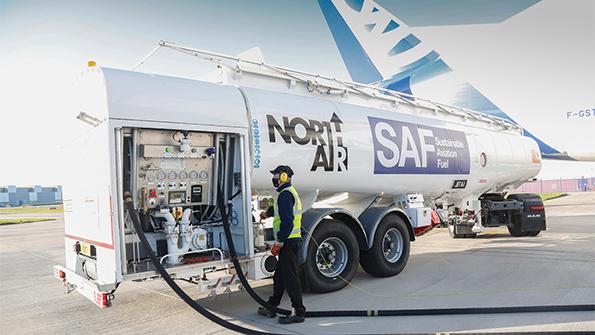

With the worst of the pandemic downturn hopefully in the rearview mirror, commercial aviation must now move on to face its greatest challenge yet: How to achieve net-zero emissions by 2050.
Governments are making commitments to incentivize sustainable aviation fuel (SAF)—Europe, through February’s “Toulouse Declaration,” and the U.S., with the Biden administration’s aim to have enough SAF to meet 5-10% of jet fuel demand by 2030 and 100% by 2050, including through tax credits. A growing list of nations, industry associations, airlines and manufacturers have voiced their intentions, positioning SAF to play a key role in achieving net zero.
Although still in its infancy for adoption, SAF has generated excitement as an attractive “bridge” to future technologies that may eventually include zero-emission aircraft. While SAF produces carbon emissions, many feedstocks are considered largely carbon-neutral as they “catch and release” already emitted CO2. eFuels are especially promising, given their potential to reduce life-cycle emissions by 90% compared with Jet A when combined with renewable sources of electricity and CO2.
As a drop-in fuel, SAF is mostly compatible with today’s engines and does not require costly fleet replacements. And unlike other propulsion technologies—such as electricity and hydrogen, which will be limited to short- and medium-haul missions, given energy and volumetric density limitations—SAF offers a ubiquitous option.
Several pathways are already approved at blends of up to 50%, with the feasibility of 100% SAF flights already demonstrated, including a passenger-carrying United Airlines Boeing 737 MAX. Thus, many commitments have been made by public and private stakeholders to produce and purchase SAF.
But the ugly truth is that the sky is not the limit with SAF. A recent Bain study on future aviation propulsion technologies deeply explored the technical and infrastructure challenges to producing alternative fuels, including projecting future economics for production of SAF and liquid hydrogen at scale.
Our conclusion is that despite aggressive assumptions around technology and efficiency improvements over the coming decades, SAF production cost and supply availability will fail to meet aviation needs, falling short even with government incentives and mandates that spur early investments and adoption.
Today’s SAF primarily centers on hydroprocessed esters and fatty acids (HEFA), which account for more than 85% of all announced SAF and renewable diesel production capacity beyond 2025. Feedstocks for HEFA make up more than 80% of costs and present unique supply challenges. Inputs of used cooking oil and animal fats have significant dis-synergies of scale, whereby collecting incremental material gets harder.
And even in a nascent state, demand from SAF and other biofuels has already pushed up input prices significantly, more than doubling them in the past two years, leading to perverse incentives attracting nonsustainable feedstocks like virgin palm oil. Ultimately, theoretical supply is capped at around 40 metric tons, which would address less than 10% of 2050 Jet A demand.
Other feedstocks like biomass, municipal solid waste and the holy grail of eFuels will require trillions of dollars in capital outlays. By our estimates, $1.3 trillion in processing and renewable energy would generate less than a 25% share of 2050 Jet A demand, and it would take more than $10 trillion to theoretically reach 100%.
Notably, refinery economics currently favor renewable diesel production over SAF production, so choosing aviation—which has fewer alternatives like electric-vehicle technologies already viable at scale—will require incentives and/or mandates.
Ultimately, costs of SAF estimated at 2-3x historical Jet A prices would need to decrease. While today’s elevated oil prices may help to reduce this gap, higher ticket prices would inevitably eat into travel demand.
To decarbonize commercial aviation, unless we are prepared to cap aviation traffic, the industry will eventually need to accelerate other technologies into its fleet and, more likely than not, require more time to get there.
Massive investments and incentives well beyond current committed levels are needed to accelerate other technology development and necessary infrastructure spending. Meanwhile, competing technologies are likely to split scarce investment resources and lead to delays in technology adoption.
Given that aircraft last on average a little more than 20 years and that technologies are unlikely to be available for mass adoption across fleets well into the 2040s, setting an improbable 2050 target can feel disingenuous.
Tough choices will need to be made. Either travel will once again become a luxury good, or targets will need to be revisited as we bet on scaling up technologies that largely only exist in the lab today. And these will need to be better aligned with the realities of physics, feasible technology maturation timelines and the limits of SAF feedstock capacity at reasonable prices.
Jim Harris is a partner at Bain & Co. and co-leads the firm’s Americas aerospace, defense and government services practice.
The views expressed are not necessarily those of Aviation Week.